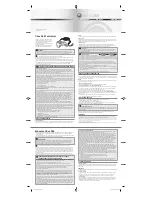
Page
3
of
18
LED NOT LIT, ACTUATOR DOESN’T WORK
REPORTED FAULT
POSSIBLE REASON(S)
POSSIBLE SOLUTIONS/ ADVICE
LED not lit
No external power
arriving at the
actuator, or actuator
damaged due to wiring
error.
•
Check wiring AT THE ACTUATOR’s GREY DIN PLUG matches the wiring on the actuator’s wiring diagram (affixed to actuator).
•
Check for loose wires in the DIN plug, or bare wires/ strands shorting across 2 terminals.
•
Check for damaged or trapped cables.
.
•
The difference between the wiring connections of the power (grey plug) and end of travel (black plug) wiring has been missed resulting
in a short circuit blowing the main PCB.
•
The plugs have been swapped so the grey power plug was fitted to the black base, creating an internal short circuit resulting in a
catastrophic blow-out on the limit-switch sub-PCB. Thereafter plugging the grey power plug back into its correct base would not show a lit
LED.
•
Is the correct voltage being applied?
Check voltage being applied AT THE ACTUATOR DIN PLUG* is within the range shown on the actuator ID label;
(a) when the DIN plug is not fitted to the actuator and
(b) when it is connected to the actuator and driving actuator (checks for undersized power supply)
* Checking AT THE ACTUATOR DIN PLUG eliminates any issues in the connection between the power source and the actuator – it is
imperative that the voltage the actuator sees is being measured, not the output from a controller/ panel.
•
Insufficient power intensity available, this could be;
a) undersized power supply and/ or transformer
b) inrush not allowed for (power supply should be the maximum actuator consumption x 3)
c) voltage drop due to length of cable, particularly in DC systems
d) control panel issue
e) actuators connected in parallel (prohibited)
f) damaged cable(s)
g) loose connections (may be but not necessarily in the Din plug – could be anywhere in the supply cable route/ system)
h) Supply circuit fuse blown/ breaker out
. . . or it could be a combination of these
•
Actuator PCB fault.
If the customer confirms that all of the above checks have been carried out and that they are sure that the actuator is receiving the
correct voltage when power is being applied and that all wiring and signalling is correct, there could be a PCB fault. However, this is very
rare, and in most cases the cause is down to a wiring, or power supply issue. See ‘PCB’ later in this document.




































